It’s common for artists to draw divine inspiration from famous figures as models for their craft. And in the wonderful world of Disney, the artisans and cartoonists who create the devious and devilish villains populating their many animated movies are often plucked from real life. History, Hollywood, even friends and family – all are fodder for creating the infamous bad guys we see on the screen.
1. Eleanor Audley’s Regal Disposition Inspired Both Maleficent And Lady Tremaine
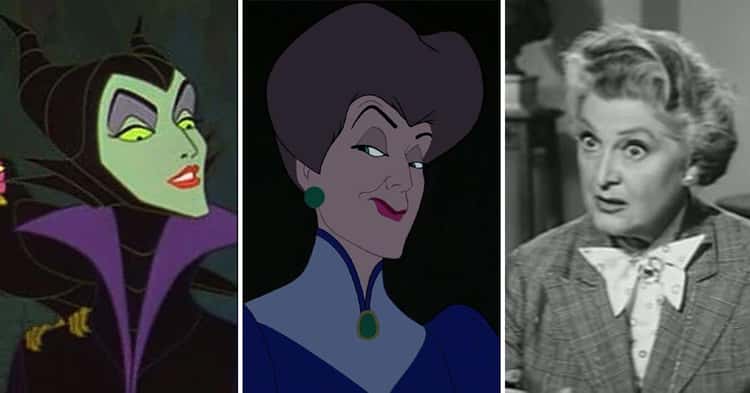
Actress Eleanor Audley was a Broadway star and radio actress before she lent her voice to two of Disney’s most malicious villains: Lady Tremaine in 1950’s Cinderella and Maleficent in 1959’s Sleeping Beauty. However, it wasn’t just her unique vocals that Audley offered to the evildoers.
While her distinct vocal stylings allowed the classically trained performer to bring Maleficent and Lady Tremaine to life by giving them a dignified and imposing tone, Disney animators also looked to the actress as an inspiration for the villains’ appearance; the animators borrowed Audley’s facial features for both sinister women.
2. King Candy In ‘Wreck-It Ralph’ Is A Tribute To Vaudeville Actor Ed Wynn
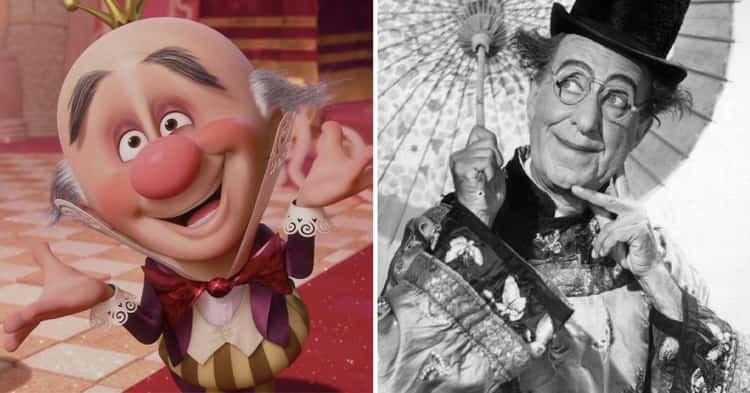
When giving life to King Candy, the corrupt ruler of Sugar Rush in 2012’s Wreck-It Ralph, actor Alan Tudyk was asked if he could mimic Disney legend Ed Wynn, who voiced the Mad Hatter in 1951’s Alice In Wonderland and starred as Uncle Albert in 1964’s Mary Poppins. As Tudyk related:
I don’t know whose original idea that was – maybe [directror and co-writer] Rich Moore’s…
…He [Wynn] never really got to do a bad guy like that.
Best known for playing fun-loving, madcap characters for most of his career, Wynn’s distinct facial features, voice, and body were the creative template for King Candy, the facade used by the evil Turbo to take over Sugar Rush from its rightful ruler, Vanellope.
3. Cruella de Vil Was Based On Hollywood Starlet Tallulah Bankhead
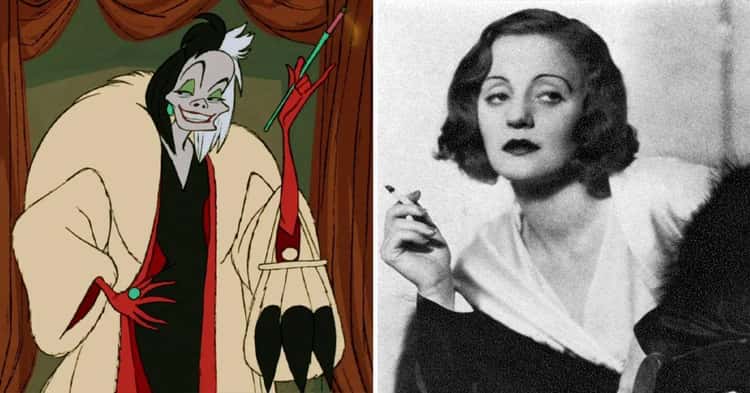
When legendary Disney animator Marc Davis was looking at models for inspiration to bring the villain from author Dodie Smith’s 1956 book The Hundred and One Dalmatians to animated life, one person stuck out in both looks and spirit:
I had several partial models in mind when I drew Cruella… including Tallulah [Bankhead] and one woman I knew who was just a monster: She was tall and thin and talked constantly – you never knew what she was saying, but you couldn’t get a word in edgewise. What I really wanted to do was make the character move like someone you wouldn’t like.
Known for her wild antics, fur coats, constant smoking, and reckless driving, Bankhead became the mold for Cruella – albeit an exaggeration to the extreme.
4. Ernesto de la Cruz From ‘Coco’ Was Based On Two Famous Musicians
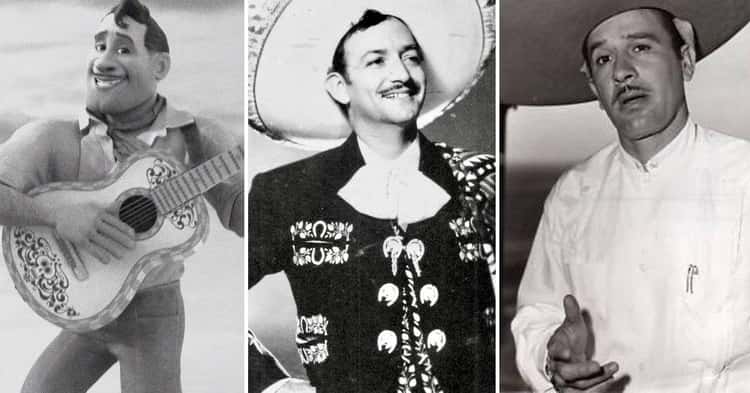
To play the role of the murderous musician Ernesto de la Cruz, filmmakers for 2017’s Coco told actor Benjamin Bratt to watch old films from Mexican cinema to draw inspiration. From there, he discovered the work of Pedro Infante and Jorge Negrete, whom he described as:
Guys who were as popular and talented as Frank Sinatra in their day. Gentlemen who were as well known for their beautiful singing ability as they were for their star-making roles in films.
Dashing and charismatic, both Negrete and Infante shared many attributes with Ernesto as far as looks and swagger, from costume to confidence. Both were highly regarded Mexican ranchera singers and leading actors from the 1930s through the ’50s.
5. Ursula The Sea Witch From ‘The Little Mermaid’ Was Inspired By Divine
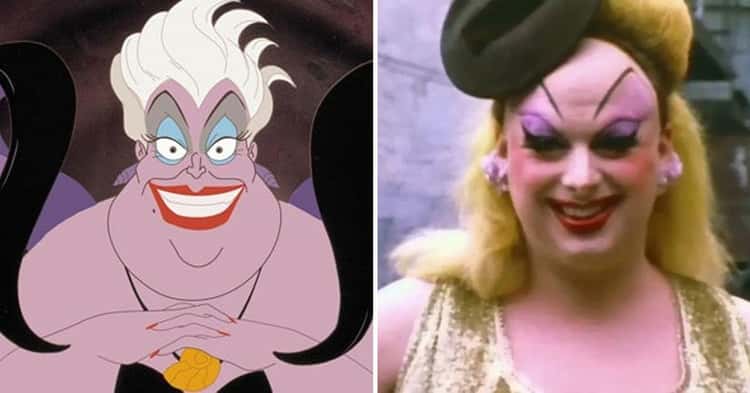
A large, in charge, and histrionic Disney villain with too much eye shadow looking to claw her way to the top by any means necessary? Is it really any surprise that Ursula the Sea Witch was inspired by one of the best and brightest drag queens of all time?
Howard Ashman, co-producer (and co-lyricist) for 1989’s The Little Mermaid, drew inspiration from the same Baltimore scene in which drag queen, singer, and actor Divine rose to fame. After Ashman’s success on Broadway with Little Shop of Horrors, Walt Disney Studios brought him in to help tinker with a little story about a mermaid who fell for a human.
Wanting to go over-the-top and campy with the supporting characters, Ashman used Divine for inspiration in looks, makeup, attitude – and, of course, “body language” – to create Ursula. He was sure that Divine, who out of drag was known as Glenn Milstead, would have loved to play the part, but passed before production was complete.
6. Charles F. Muntz From ‘Up’ Was Based On A National Hero And A Walt Disney Foe
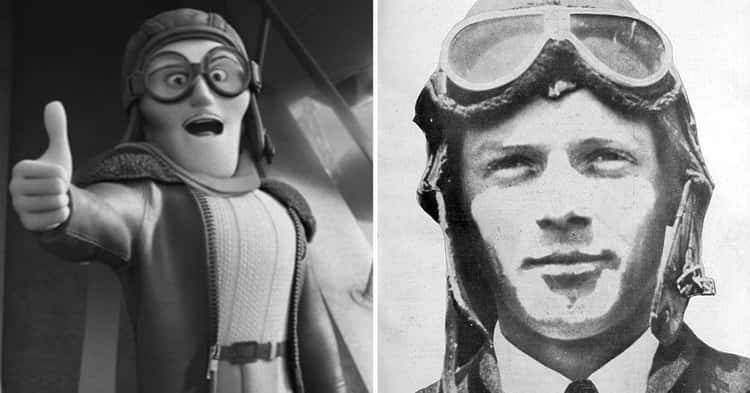
In the 2009 Disney film Up, Charles F. Muntz is based on American aviator and adventurer Charles Lindbergh. Even Muntz’s plane, The Spirit of Adventure, is modeled on Lindbergh’s The Spirit of St. Louis. As the first person to fly alone across the Atlantic and a WWII hero, Lindbergh cemented himself as a national treasure. Even his iconic look of aviator goggles and cap were modeled by a younger Muntz in the film reels – before his fall from grace, that is.
While his early mannerisms and general swashbuckling came from Lindbergh, Muntz’s name is similar to a less than stellar figure in the history of the Walt Disney company – allegedly.
Muntz’s moniker is similar to Charles Mintz, the Universal Pictures executive Walt Disney believed had stolen his first creation, Oswald The Lucky Rabbit. In the 1920s, Mintz took Oswald from the Disney brothers, as well as many of their artists, forcing them to start anew with a little mouse. The rest, as they say, is history.
7. Captain Hook’s Look Is Supposedly Based On King Charles II, But His Face Is Based On His Voice Actor
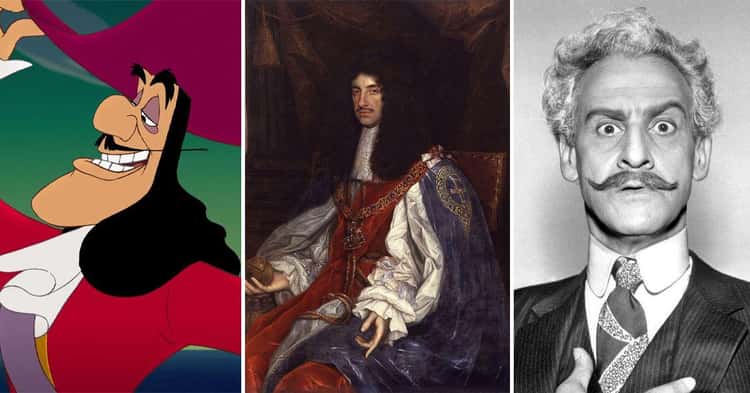
In JM Barrie’s original stories of Peter Pan, Captain Hook is described as a well-dressed man with long black curls, and handsome yet fierce:
In person he was cadaverous and blackavized, and his hair was dressed in long curls, which at a little distance looked like black candles, and gave a singularly threatening expression to his handsome countenance. His eyes were of the blue of the forget-me-not, and of a profound melancholy, save when he was plunging his hook into you, at which time two red spots appeared in them and lit them up horribly.
In the 1953 Disney film, the studio took the description to heart and made Hook bear a striking resemblance to the Spanish monarch King Charles II. But for facial features, the studio once again looked to the voice actor for inspiration. In this case, Hans Conried lent his distinct voice and look to both Hook and Mr. Darling, a long-standing tradition in any Peter Pan production.
8. Scar In ‘The Lion King’ Was Modeled After Jeremy Irons Once The Actor Was Cast
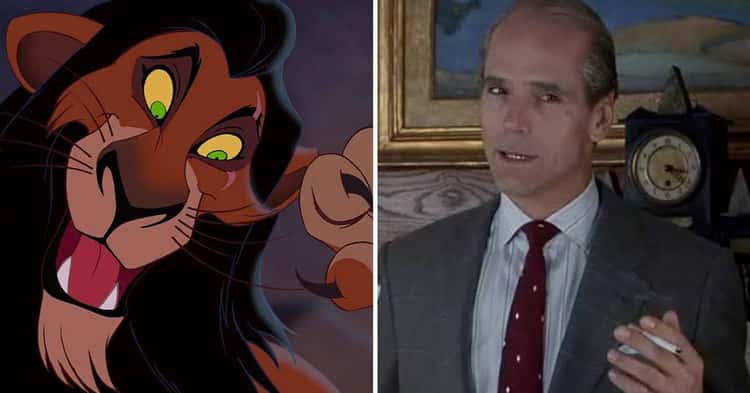
When veteran Disney character animator Andreas Deja was assigned the character of Scar while working on 1994’s The Lion King, he said began looking at Jeremy Irons movies and stills as inspiration for the character:
He’s got these dark circles under his eyes [and] he smokes, and so I said, “Let’s give Scar these same dark circles.” There’s a certain mouth configuration that Jeremy Irons also has when he speaks that I tried to also capture with Scar. In the end he is sort of a caricature of Jeremy Irons!
In the end, Deja incorporated facial expressions from Irons’s performances as Claus von Bülow in Reversal of Fortune (1990) and Dr. Stephen Fleming in Damage (1992). At one point, Scar even quotes an infamous line from von Bülow: “You have NO idea!”
9. Moana’s Crab, Tamatoa, Pays Tribute To David Bowie
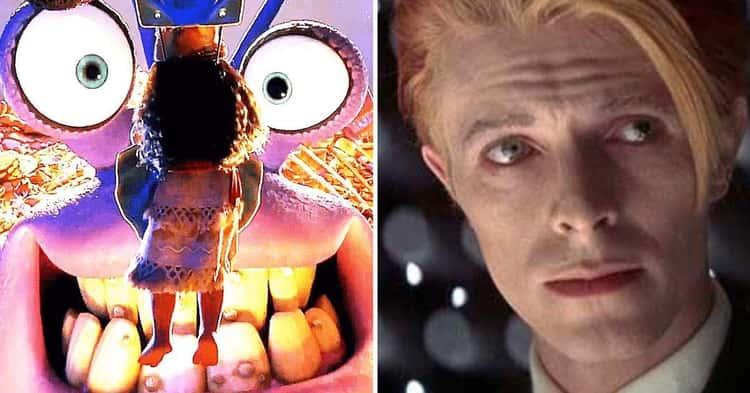
In the 2016 film Moana, Tamatoa is a villainous yet musical monster coconut crab and avid collector of all things shiny. The “beady-eyed bottom feeder” is also a big fan of glam rock. Written by Lin-Manuel Miranda and voiced by Flight of the Conchords star Jermaine Clement, the song “Shiny” was a tribute to David Bowie. According to Miranda, he wrote it just after Bowie January 2016 passing:
The world had already been mourning Bowie, I’d been listening to Bowie on a loop. I was like, well, I’m writing a glam rock tune for this crab, this jewel-encrusted crab.
In addition to the song, Tamatoa also shares a physical characteristic with the Thin White Duke. If you look closely, one of the crab’s pupils is larger than the other. This was a well-known attribute of Bowie, who had anisocoria (pupils of different sizes) after one eye got injured after a schoolyard brawl.
